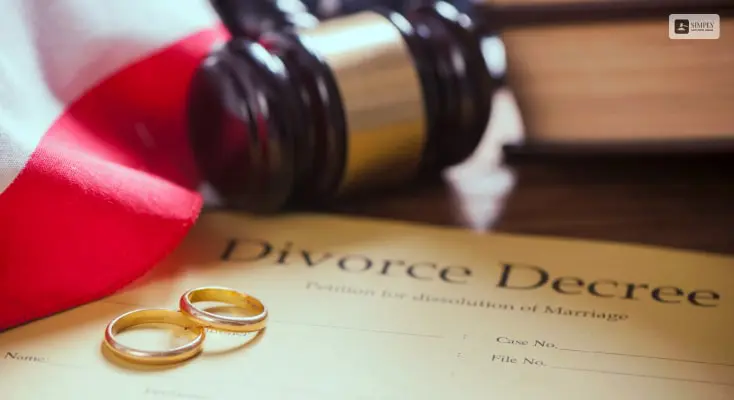
Are you or a loved one thinking about getting a divorce? Do you worry about the stigma that comes along with it? Are you afraid to talk about it publicly? Do you find yourself searching “How to file for divorce?”-
If yes, we are here to walk you through it.
In this article, we will give you a brief guide on what divorce entails, your rights and duties as the person filing for it, and a guide on what to do afterward. We are going to take a step-by-step approach. By the end of the article, you have a wholesome understanding of Divorce in the US.
So, if you want an answer to “how to file for divorce?” keep reading.
What Is Divorce?
If you are here Google searching, “How to file for divorce?” there is a 90% chance you are well aware of what it means. However, here at SimplyLawZone, we welcome one and all. That is exactly why we will start by discussing what Divorce means according to US law.
According to the principles of family law, divorce means the dissolution of marriage.
What Is Marriage?
Marriage is an institution that two people voluntarily enter into. It is a social and legal Union between two individuals. By getting married, they enter a formal relationship through a legal contract.
For as long as most of us have been alive, we have seen marriage to be a commitment based on partnership, responsibilities, and love. However, all is not hunky dowry when it comes to the practical world.
In Comes Divorce
Sometimes, people may start facing problems in their marriage. They may choose to separate through a legal means of dissolution. Divorce is that option through which a couple terminates their domestic partnership.
- They formerly and legally put an end to their marital relationship. Divorce commonly takes place along with property division, child support, child custody, spousal support, and other provisions.
- Marriage and divorce laws vary from one state to another in the US. However, how to file a divorce, what are the legal requirements to file for a divorce, and other formalities remain the same throughout States.
- Usually, all states require either of the parties to file for a divorce. The person filing for the divorce is called the petitioner. The other party is called a respondent. The petitioner has to arrange for the petition to reach the respondent.
The respondent responds to this petition. Court hearings take place to resolve disputes between the parties. Finally, the court delivers the divorce decree. After that, the marriage officially ends.
Divorce Throughout Time

Your simple question of “how to file for divorce” was not so simple back in the 18th Century.
- Not everyone enjoyed the right to divorce, especially not women. Earlier, divorce in the United States was rare. It was even considered a taboo.
- The courts only allowed it in extreme cases of adultery or abandonment.
- Finally, in the 19th century, the no-fault laws came into practice. Through these, a person could file for divorce for other reasons.
- The 20th century saw an important role in women’s rights. The women’s rights movement brought about more equal divorce laws catering to the rights of women.
- In the 1970’s no no-fault devices were a part of California State laws.
Development Of Divorce Laws
Slowly and steadily, divorce laws developed throughout the nation. Divorce rates in the United States continue growing with time. Slowly, same-sex divorce and marriage laws are becoming a part of US family laws. This evolution of divorce laws in the United States shows a change in societal values.
The Divorce Petition

If you are looking for an answer to the question of how to file for divorce in the USA, we got you. Let us first find out what filing for a divorce means.
- Filing for a divorce in the United States is a legal process. A married couple wanting a divorce can approach the court through this.
- The person filing for the divorce is called the petitioner. Through a divorce petition, the petitioner submits legal documentation to a court having appropriate jurisdiction.
- This petition shows their intention of bringing the marriage to an end.
Components
A divorce petition contains the following:
- reasons for which either spouse wants a divorce,
- terms on the spousal support they need,
- Terms dictating child support,
- child custody requirements,
- terms dictating property division,
- and more grounds.
Each divorce petition differs from the other.
Here’s What To Know Before Filing

These are the things you should keep in mind before you file for divorce.
A divorce petition is an initiation of a legal process. This is why you should be sure before filing for a petition. You should take the petition as seriously as any other legal process.
Your Petition Will Be Legally Binding
A divorce petition is a legally binding document. It will have consequences for all parties involved. The petition will decide on major factors such as spousal support, child support, property division, etc.
Reasons For Filing Divorce
The petition will contain the reason why the petitioner is seeking divorce. There are a variety of reasons. It can be due to the fault of either party or due to the fault of neither.
You will have to check if your state has provisions for no-fault divorces
You Will Have To Find The Petition In The Proper Jurisdiction
Before you file for a divorce, please check what jurisdictions you can file it under. It can be where either of the spouses resides. If you submit the divorce petition in a court having the wrong jurisdiction, the court will reject the petition.
Filing For The Petition Alone Will Not Do
It is the duty of the petitioner to serve the petition to the other spouse. This is to give the other party due notice of the proceedings. You can serve your petition through a registered mail service. Your state laws may ask you to deliver the notice by means of publication or even personal service.
Spousal Duty
After the other spouse receives the petition, it is their duty to respond to it within a specific time period. They can either agree to the terms and conditions of the petition, or they can contest it in court. The time within which the respondent has to send in their response is 20 to 30 days.
The Next Step In The Response Is Negotiation
Negotiations and mediations are methods of alternate dispute resolution. Alternate dispute resolution methods save time and money for both parties. The goal is to solve disputes without getting the court involved.
I’ll See You In Court
If either spouse cannot reach an agreement through alternate methods of dispute resolution day, proceed to court. Divorce proceedings can get messy. Laws relating to divorce trials can differ from state to state. The proceedings include hearings, presentation of evidence conference, etc.
Judgment Day, The Final Stage
No, we are not talking about the biblical Judgement Day. When the court having appropriate jurisdiction delivers the final verdict on the divorce trial, the marriage officially ends. Court rulings may contain terms regarding custody, child support, spousal support, child custody, visitation agreements, etc.
How To File For Divorce In The United States?

In this section, we answer your most important question. How to file for divorce if you are a citizen of the United States?
Before we get the answer to this question, we must understand the different types of divorce. The type of divorce you opt for will determine the divorce filing process. So let us look into it without much delay.
Type 1, The No-Fault Divorce
No-fault divorce is actually the most common type of devotion in the United States. In this type, either spouse does not have to blame the other party to get a divorce.
They can simply state an “irreconcilable difference” as the reason. No-fault divorces are currently available in all states in the US. Since these divorces are the least complicated ones, you can opt for a do-it-yourself approach.
You have to decide the jurisdiction where you want to file for divorce. Discuss with your spouse.
- Look into the requirements according to your state laws.
- Negotiate the terms and conditions with your spouse and reach an out-of-court agreement.
- File the paperwork (divorce petition) with your court.
- Complete all pretrial requirements. This includes a complete financial disclosure to your spouse and the judge.
- Attend the court hearing where you present evidence to the judge.
- Get the judgment, and that’s it. You are divorced!
Type 2: Fault-Based Divorced
A no-fault divorce is the most common type in the U.S. It allows couples to divorce without assigning blame to either party. Spouses can cite “irreconcilable differences” or similar reasons for the divorce. No-fault divorce is available in all states.
- Various states of the US still allow fault-based divorce.
- Through it, one spouse alleges that the other one committed wrongdoing.
- A fault-based divorce can take place on grounds such as adultery, cruelty, or abandonment.
- The petitioner filing for a fault-based divorce will have to prove the fault of the other party.
A General Guide To The Process

So, how to file for divorce step by step? We will answer it for you.
- Filing for divorce in the United States involves several steps and can vary depending on the state in which you reside. Here is a general overview of the process:
- However, please bear these in mind. Before you file for a divorce, you must meet residency requirements.
- Family law is the jurisdiction of the state. Therefore, residency requirements can vary from one state to another.
Usually, state laws require you to file for divorce in a state where you or your spouse have lived for a minimum time. It can be anywhere from 6 months to a year.
Step 1
You will have to determine what grounds you will pursue the divorce on. If you choose to go for a no-fault divorce, you can cite the reason for irreconcilable differences.
If you live in a state that allows false-based divorce, you can refer to the misconduct by your spouse. Common grounds for a fault-based divorce are cruelty and adultery.
Step 2
Hire a divorce attorney. Whether or not you think you need a divorce lawyer, we suggest you hire one.
The legal process of getting a divorce can be pretty complex. It involves multiple legal principles of child custody, spousal support, property division, and whatnot. A divorce lawyer will make the whole process easier for you.
Step 3
Collect all relevant information on yourself and your spouse. The information should be relevant to either party. It can be financial and personal in nature. This is what it can include:
– Marriage certificate
– Birth certificates of children
– Financial records (assets, debts, income)
– Property documents
– Employment and income information
– Details about child custody and other support arrangements.
Step 4
The next step is filing the petition. For this purpose, you need to prepare the divorce petition with the help of an attorney.
- The divorce petition is a formal document that initiates officially the divorce process.
- To file a petition, you’ll need to fill up the necessary forms These forms are usually available at your state Bar Association’s websites.
- The state makes sure that these are easily available online. Individuals going through a tough time in their marriage do not have to work hard to get their hands on it. You can also collect them from your local courthouse.
- If you have a divorce attorney, they will arrange for the petition for you.
A divorce petition typically includes the following details:
– Full names of the petitioner and the respondent
– The grounds for divorce
– Information about children
– Relief claimed by the petitioner
– Clauses regarding property division
– Conditions related to alimony
– All other relevant details that your attorney deems fit
Step 5
Like all other petitions, a divorce petition comes with a payable fee. Once you have paid the Fee, your petition is submitted to the court. If you cannot pay the fee due to financial restrictions, you can make an application for a fee waiver.
This concept is known as “informa pauperis”. It means that you appear to the court in the manner of a pauper.
Step 6
Now is your turn to serve the Divorce Papers to your spouse. This step is mandatory. It helps you formally notify your spouse of the divorce. You serve them the divorce papers through which they will get to know of your claims and relief terms.
Typically, a spouse is required to deliver divorce papers through a server, sheriff, or via certified mail. The method may vary depending on your state’s requirements.
Step 7
The Respondent has to reply. The main purpose behind serving the divorce petition is to notify your spouse. They will have to acknowledge the petition by sending their response. However, they do not have forever to do that.
Your spouse has to reply within a certain period, usually 20-30 days. to respond to the divorce papers. If they are agreeing to your claims in the petition, they can sign it in agreement.
If they do not agree, they can file a response with the court and state their counterclaims.
Step 8
Try for Alternate Dispute Resolution techniques. It is very common to have disagreements on issues like property division, child custody, or support. They mostly arise after your spouse has gone through the petition terms.
If you and your spouse cannot agree on the terms of the petition, you can try negotiation and mediation. If it works out, you will be able to reach an agreement outside of court.
Step 9
Unsuccessful negotiations can lead to a divorce trial. The trial is, therefore, the next step. If you and your spouse do not see eye to eye on all issues, the case may go to court. Divorce trials vary from one state to another. The process includes multiple hearings.
Details Of A Trial
Each divorce trial begins with an opening statement. In it, both parties clearly state their position to the court. They state their claims and proof of the claims.
- Next, both parties present evidence to back up their own respective claims.
- It can include witness testimony, expert opinion, and other relevant information.
- After that, cross-examination of either party continues.
- Either party questions the other one’s statements and credibility.
- After documentary evidence and expert witness stages are completed, legal arguments begin.
- Divorce attorneys from both sides will bring up relevant laws and precedents.
- Next, both attorneys deliver a closing argument.
Finally, the judge delivers the judgment and orders with the finalization of the divorce.
Step 10
A divorce trial does not end with a judgment. It ends with the execution of the terms of the judgment instead.
After the divorce, both the authorities and parties have to ensure that they implement the terms of the divorce decree. You will need to carry out all necessary property transfers, alimony payments, and child custody arrangements.
Dos And Don’ts In How To File For Divorce

To ensure a smooth divorce filing and overall process, please adhere to these dos and don’ts we have listed down for you. Let’s begin!
The Dos
Your first step should be to seek advice from a divorce attorney. They will explain the whole legal process to you in simple terms.
You will also have an overall idea of your rights and duties. It is essential to know where you stand before you file for the divorce.
Do Collect All Financial Documents
This can include bank statements, pay slips, an assessment of your asset value, debts, and credits. These will help you in spousal support and child support determination.
Try Communicating Openly With Your Spouse
Maintain an open and civil dialogue. This will help you get through the divorce proceedings with mental peace.
Children’s Wellbeing
Before you sign up for the divorce petition, make sure you prioritize your children’s needs. Attorneys always advise clients to create a distinct parenting plan before filing for the divorce petition.
This ensures the well-being of their children. It also helps both parents maintain a healthy relationship with the children.
Mediation
Do look into Mediation with your spouse outside of court. Exploring mediation, negotiation, or a more collaborative approach can save both parties time and money.
Following Court Orders Is A Must
If the court passes any intermediate orders related to the divorce, you should follow them word for word. In case you don’t, you will face legal consequences. It could also make the divorce go in the opposite party’s favor.
Do Keep Records Relevant To The Divorce
All communications and transactions between you and your spouse are important when making your case to the court.
This can include emails, text messages, and even financial transactions (bills and receipts).
Don’ts
Don’t make hasty decisions. All good things, rather all things take time. We understand that there can be multiple complications you are facing at home.
Divorce probably means freedom for you and your kids. However, rushing the process will only increase the possibility of mistakes.
If You Are Having Disputes With Your Spouse, Do Not Involve Children In The Process
They do not need to be a part of adult conflicts. This will keep them from feeling negatively about their home. Children of divorce can be vulnerable.
Make sure to treat them with the love and sensitivity that the situation demands.
Do Not Lie To Your Lawyer Or To The Court
Hiding assets, lying about your income or debts, hiding property papers, or any similar behavior will only harm your case. State laws make it illegal to hide your assets during legal proceedings. Full financial disclosure helps the court make a correct estimate of spousal and child support.
Final Word
This was your complete guide on “how to file for divorce.” We hope that our article touches upon all your doubts related to the divorce filing process in the USA and relevant laws and regulations.
Please remember that divorce filing is just the beginning of the procedure. Try to co-operate with your spouse to reach an amicable divorce settlement.
We hope you found our article helpful! Do let us know your thoughts in the comment section!
Read Also:


